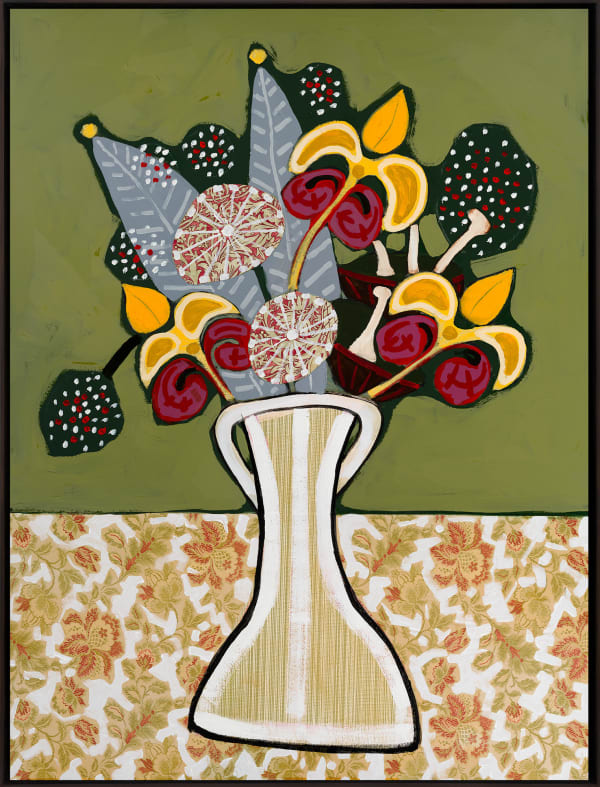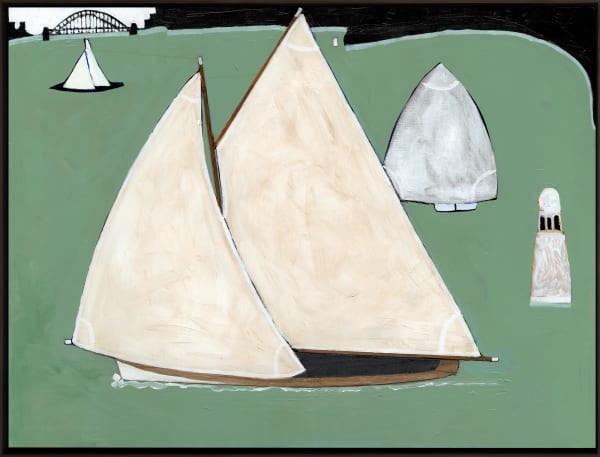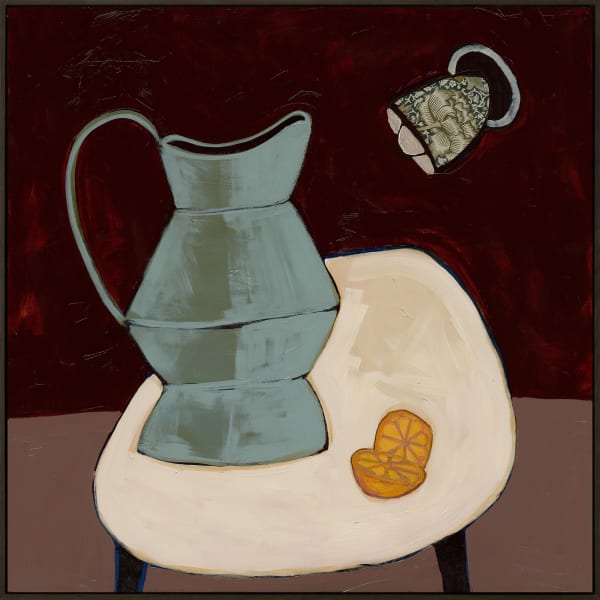John Baird: Port Jackson, Still Lifes and Otherwise
-
 John BairdWest of North Head, 2024acrylic and shellac on board100 x 100 cm, 103 x 103 cm (framed)Sold
John BairdWest of North Head, 2024acrylic and shellac on board100 x 100 cm, 103 x 103 cm (framed)Sold -
 John BairdRace Mark, 2025acrylic and shellac on board
John BairdRace Mark, 2025acrylic and shellac on board
120 x 120 cm, 123 x 123 cm (framed)Sold -
 John BairdHeading Out, 2025acrylic and shellac on board120 x 120 cm, 123 x 123 cm (framed)Sold
John BairdHeading Out, 2025acrylic and shellac on board120 x 120 cm, 123 x 123 cm (framed)Sold -
 John BairdHornby, 2025acrylic, shellac and balsa wood on board120 x 120 cm, 123 x 123 cm (framed)Sold
John BairdHornby, 2025acrylic, shellac and balsa wood on board120 x 120 cm, 123 x 123 cm (framed)Sold -
 John BairdRising Sun, 2025acrylic and shellac on board120 x 120 cm, 123 x 123 cm (framed)
John BairdRising Sun, 2025acrylic and shellac on board120 x 120 cm, 123 x 123 cm (framed)
-
 John BairdCollaroy, West of North Head, 2025acrylic and shellac on board120 x 120 cm, 123 x 123 cm (framed)
John BairdCollaroy, West of North Head, 2025acrylic and shellac on board120 x 120 cm, 123 x 123 cm (framed) -
 John BairdEvening, 2025acrylic and shellac on board120 x 120 cm, 123 x 123 cm (framed)Sold
John BairdEvening, 2025acrylic and shellac on board120 x 120 cm, 123 x 123 cm (framed)Sold -
 John BairdHome jug, 2025acrylic, wallpaper and shellac on board120 x 120 cm, 123 x 123 cm (framed)
John BairdHome jug, 2025acrylic, wallpaper and shellac on board120 x 120 cm, 123 x 123 cm (framed) -
 John BairdAshtray, 2025acrylic, wallpaper and shellac on board120 x 120 cm, 123 x 123 cm (framed)
John BairdAshtray, 2025acrylic, wallpaper and shellac on board120 x 120 cm, 123 x 123 cm (framed) -
 John BairdInterior with Apple, 2025acrylic, wallpaper and shellac on board
John BairdInterior with Apple, 2025acrylic, wallpaper and shellac on board
120 x 120 cm, 123 x 123 cm (framed)Sold -
 John BairdCasserole, 2025acrylic, wallpaper and shellac on board120 x 120 cm, 123 x 123 cm (framed)
John BairdCasserole, 2025acrylic, wallpaper and shellac on board120 x 120 cm, 123 x 123 cm (framed) -
 John BairdStill Life, 2025acrylic, wallpaper, shellac and balsa wood on board
John BairdStill Life, 2025acrylic, wallpaper, shellac and balsa wood on board
90 x 120 cm, 93 x 123 cm (framed) -
 John BairdFleur de lis, 2025acrylic and shellac on board90 x 120 cm, 93 x 123 cm (framed)Sold
John BairdFleur de lis, 2025acrylic and shellac on board90 x 120 cm, 93 x 123 cm (framed)Sold -
 John BairdInterior with painting, 2025acrylic, wallpaper, shellac and balsa wood on board
John BairdInterior with painting, 2025acrylic, wallpaper, shellac and balsa wood on board
90 x 120 cm, 93 x 123 cm (framed)Sold
-
 John BairdQuiet Passage, 2025acrylic, shellac and balsa wood on board
John BairdQuiet Passage, 2025acrylic, shellac and balsa wood on board
100 x 100 cm, 103 x 103 cm (framed)Sold -
 John BairdLaunch, 2025acrylic and shellac on board
John BairdLaunch, 2025acrylic and shellac on board
100 x 100 cm, 103 x 103 cm (framed) -
 John BairdPort Jackson Arrangement, 2025acrylic, shellac and balsa wood on board
John BairdPort Jackson Arrangement, 2025acrylic, shellac and balsa wood on board
120 x 90 cm, 123 x 93 cm (framed)Sold -
 John BairdFavourite Track, 2025acrylic and shellac on board100 x 100 cm, 103 x 103 cm (framed)
John BairdFavourite Track, 2025acrylic and shellac on board100 x 100 cm, 103 x 103 cm (framed) -
 John BairdGreen jug, 2025acrylic, wallpaper and shellac on board100 x 100 cm, 103 x 103 cm (framed)
John BairdGreen jug, 2025acrylic, wallpaper and shellac on board100 x 100 cm, 103 x 103 cm (framed)
John Baird’s latest exhibition at Arthouse comprises two-thirds seascapes and one-third still life. Both are familiar subjects, though each has been given a dramatic twist. The colours are more intense, the shapes seem bolder, razor-sharp at times, the horizon looms large up ahead, then retreats into the distance. A shared sense of recognition between artist and viewer is established, but one that is stretched, strained, pushed and pulled. Familiar landmarks and common table arrangements have gained new and unexpected meanings.
John’s declaration: ‘I like the harbour, and I like painting’ is borne out of these new works. The artist’s ongoing exploration of the frisson between the real and the imagined is on show. There is an innate difference between what is seen and what can be felt. It is very much the artist’s take on the world, but he is also equally dependent upon us to play along.
Late in 2024, John Baird was invited to Sydney to take part in Arthouse’s 30th anniversary celebrations. He met up with other gallery artists, took ferry trips and stayed in a room with views of the majestic Sydney Harbour. The resulting paintings were completed in his Melbourne studio from photographs and sketches. Inspired by Sydney’s sights and sounds, Baird focussed on prominent and instantly recognisable locations such as the Sydney Harbour Bridge, Opera House, harbour forts and North Head. What John calls Sydney’s ‘iconoscenery’ was observed, stripped back and then reloaded again, in concert with his love of the sea, sailing, and mark-making in general. The concerted flurry of intense activity extended to painting another of his pet interests, domestic tableaux and still lifes.
John Baird does not aim for topographical or pictorial accuracy in either genre. In his eyes, the pictures can be viewed as ‘wrong’, in the sense that they are not aiming at some sort of universal truth or verisimilitude. In the seascapes, for example, he operates from an awareness of the conventions of the early European seafaring artists who charted unfamiliar territory by assiduously sketching distant headlands, open passages and the depth of water. Baird takes on aspects of this more rational approach but then turns any systematic desire for ‘all-knowingness’ on its head. His 21st century practice has less to do with placing the unfamiliar under control, as it has to do with taking what is now familiar and remaking it anew.
To this extent, John Baird’s Sydney Harbour paintings are richly loaded evocations that ameliorate past histories and combine fresh observations with memories, shared experiences and storytelling. The surfaces in these pictures pulsate as they do in the arrangement of his still lives. In these, a genre that can be characterised as unassuming is viewed through the lens of mid-20th century English painting and 19th century arts and crafts design. William Morris wallpapers are embedded into the surface of the ply. The shellac base gives a mellowing, tonal uniformity to each picture that inculcates the passing of time. Such formal devices and inclusions have a distinct purpose beyond the facility of shared recognition. Pressed into service, they form the basis of the artist’s aim – to encourage conversations by creating well resolved and playful pictures.
Rodney James — Curator and Writer
























